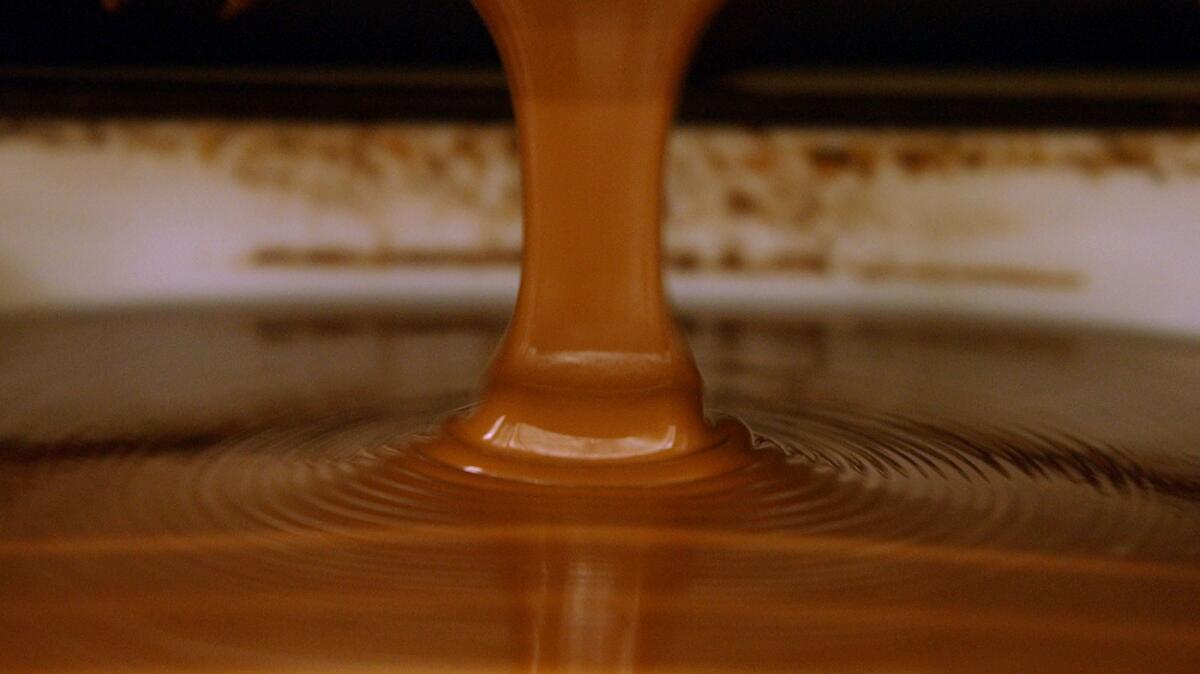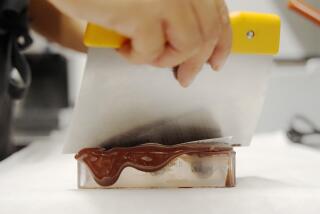Electric field can make chocolate more healthful, and some say tastier

- Share via
Leave it to scientists to take something as awesome as chocolate and make it even better.
By running liquid chocolate through an electric field, they were able to remove up to 20% of the fat while making the end product tastier.
Like so many great scientific discoveries, this one happened by accident. The researchers who came up with the new chocolate-making method were merely aiming to improve its viscosity, so that it wouldn’t clog the machinery in manufacturing plants.
Rongjia Tao, a physicist at Temple University in Philadelphia, had used a similar technique to improve the viscosity of crude oil so that it would be easier to transport through miles of underwater pipelines.
A consulting firm working on behalf of Mars Inc. — the company that makes M&Ms and Snickers bars — reached out to him to see if the method might apply to chocolate as well, he said.
If so, the implications could be huge. Americans spend more than $21 billion on chocolate a year, making it the top-selling candy in the U.S., according to the National Confectioners Assn.
Chocolate beans have two main components — cocoa solids (the part that gives chocolate its distinctive flavor) and cocoa butter (the fat that gives it its rich texture). After the beans are roasted, they are milled into a liquid form.
That’s where things can get messy.
See the most-read stories in Science this hour >>
At a microscopic level, the mixture consists of tiny, circular cocoa solids that randomly bump up against each other in the liquid suspension of melted fat and oil.
Imagine a bunch of identical balls thrown into a container, Tao said. Even when the container is full, there are still air pockets between the balls. But no amount of liquid would move them, once they’re all jammed together.
As no less a scientist than Albert Einstein has observed, the randomness of the balls is what drives the thickness, or viscosity, of the liquid. This principle applies to the cocoa solids in chocolate.
So to keep chocolate fluid enough to flow through processing machines, there has to be a certain amount of melted fat mixed in. If chocolate is too thick and gooey, it simply won’t move at the required pace.
Tao and his colleagues thought they might be able to solve the problem by borrowing an electric pulse technique from the oil industry.
In the lab, they built their own device so they could measure the rate at which chocolate flowed through a tube a little wider than a cocktail straw. Before sending the chocolate into the tube, they ran it through a pipe fitted with a series of metal mesh screens that produced an electric field when a current was run between them.
As the liquid chocolate passed through the electric field, the individual cocoa solids transformed from symmetrical circles to elongated, pill-shaped chains. This allowed the solids to pack together more tightly, which decreased the viscosity of the chocolate and improved the flow.
Then Tao had an amazing insight: “I realized, this technology can not only reduce the viscosity, it can reduce the level of fat.”
With the chocolate flowing more freely, it takes less fat to keep the chocolate from clogging up the works. In several trials, the researchers found that they could decrease the fat content by 10% to 20%.
As if that weren’t enough, some members of the research team thought the electric-field-treated chocolate tasted better, too. By reducing the fat content, the cocoa solids have more of a chance to stand out, said Tao, who added that he now has more than 300 pounds of leftover chocolate in his lab.
The results were published Monday in the Proceedings of the National Academy of Sciences.
Temple University has received two patents for the new manufacturing process. The research was funded in part by Mars, though a company spokeswoman declined to say whether the company planned to use the electric-field technology.
Tao said he hopes candy makers will adopt the technique, and not just for professional reasons.
“I love chocolate and eat it quite frequently,” he said. “I will eat more chocolate once it has less fat.”
Others remain skeptical that chocolate is in need of any improvement. One of them is Marion Nestle, an expert on nutrition and public health at New York University.
“Candy is candy. It has a place in diets, just not a big one,” Nestle said. “Why not enjoy the real stuff?”
MORE IN SCIENCE:
Scientists turn plastic bottles and bags into liquid fuel
How running shoes change the muscles in your feet
Coral reef census will help scientists protect fragile underwater habitats
UPDATES:
June 21, 2:57 p.m.: This article was updated with new market data as well as comments from Marion Nestle.
June 20, 5:24 p.m.: This article was updated with additional comments from Rongjia Tao, the physicist who led the study.
This article was originally published at 2:05 p.m. June 20.






